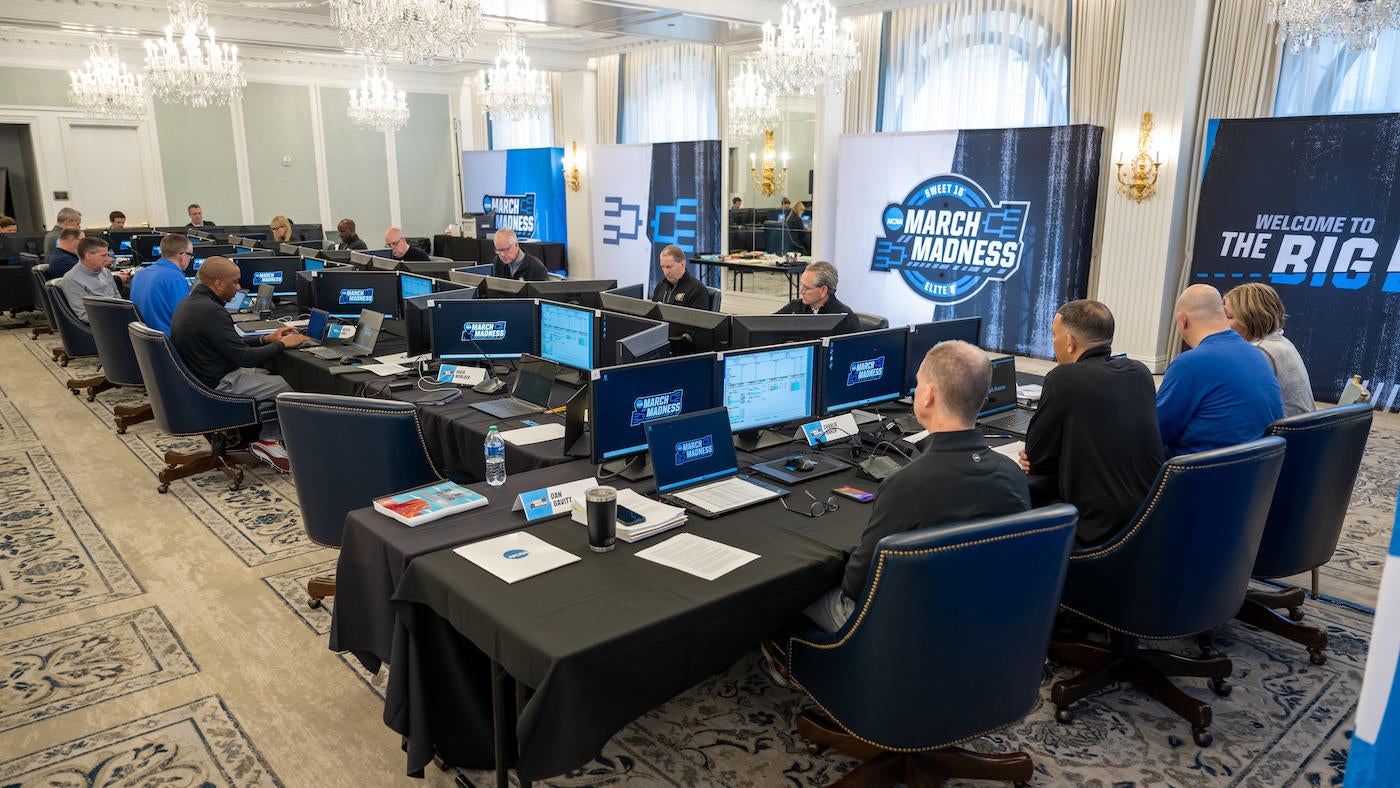Five significant reasons why the NCAA should pass on expanding the Big Dance and stick with 68 teams
Written by CBS SPORTS ALL RIGHTS RESERVED on July 8, 2024

The NCAA men’s basketball committee — a group of 12 Division I athletic directors and commissioners, the same people who determine the bracket for each season’s NCAA Tournament — are meeting this week in Park City, Utah, along with select NCAA staff to address a variety of items pertaining to March Madness.
The biggest topic on the agenda is also the most polarizing: potential tournament expansion.
While there is no guarantee a decision on expansion will be made this week, it will be the most consequential talking point. This plot will advance again, as it did a few weeks ago. The selection committee’s annual summer summit comes 19 days removed from NCAA senior vice president of basketball Dan Gavitt flying to Florida to speak at a different convocation — the Conference Commissioners Association’s meetings — to brief college sports’ heads of state on where things stands with potential expansion. We now know the NCAA is considering three options:
- Keep the field at 68 teams
- Increase the bracket to 72
- Inflate to 76
“There certainly was conversation about expansion but it was a clear that no expansion on the table, too,” said one source who heard Gavitt speak in June. “It’s not like this was presented as a guaranteed thing.”
If you’ve forgotten why tournament expansion is even a topic — other than typical sports greed — we reached this point due to the existence of the NCAA Division I Transformation Committee, a venture created in 2021 by former NCAA president Mark Emmert in the wake of the NCAA losing in the NCAA v. Alston case in the Supreme Court 9-0. In 2022, the committee recommended every D-I sport with at least 200 teams explore whether to expand its championship tournament event, and if so, to put a cap on expansion at 25% of a sport’s population. For men’s college basketball, that would have meant a maximum of 90 teams. But 90 was never on the table, and we now know nothing beyond 76 is.
It should be noted that the committee was in this spot a year ago, when it discussed expansion at its summer summit.
“The committee must be good stewards for the Division I Men’s Basketball Championship,” Gavitt said in July 2023. “They are committed to doing their due diligence looking at a few different models to make an informed decision that’s in the best interests of the championship, and that may very well include deciding against expansion.”
The best interests of the championship is the key phrase there, and one that’s been at the forefront of this issue since 2022.
Critically, the NCAA is not moving when the tournament is staged. It will continue to hold the Final Four on the men’s and women’s side the weekend before The Masters. And conference championship week isn’t moving either. March Madness will remain in the same three-week window we’ve had for decades.
So, as we wait to learn what the committee decides to do, it’s time for a reminder about why NCAA Tournament expansion is not only undesirable, it’s also wholly unnecessary. Here are five big reasons why.
1. Most sports fans are against expansion
Folks, practically nobody who truly loves this sport is asking for more than 68 teams in a basketball tournament. Most of us would go back to 64 if allowed.
As this topic has drawn out over two-plus years, there hasn’t been one convincing or compelling argument in favor of expansion either. The second you add a 69th and 70th and 71st and 72nd team to the field, you degrade what it means to qualify for the event. Is it doomsday? Of course not. Is it improving the product? No.
But the basketball committee is giving proper procedure to expansion exploration because high-major commissioners have applied pressure to do so. Still: Gavitt and people responsible for organizing and staging the NCAA Tournament are the ones holding power, not the commissioners looking to get 10th- and 11th-place teams from their conferences into the Big Dance. In fact, the NCAA Tournament is one of the few topics in American sports where a super-duper majority of fans clearly fall on one side of the issue.
They don’t want expansion.
Power-hungry commissioners, fidgety athletic directors and insecure coaches are most definitely NOT looking out for the betterment of college basketball. Adding schools is a water-down effect. It’s a bald effort to tack on four or eight more double-digit-loss teams. These games would be tossed into the mix on the Tuesday and Wednesday before the first round, by the way. Keep in mind: Every team you add to the field, that means another team is taken out of the 64-team bracket and placed into a Tuesday/Wednesday matchup. Careful what you wish for.
There is a lot to be said for appreciating a great thing for what it is and letting it exist without a tinker or a touch.
2. Expansion won’t bring much more money, if any
Another critical circumstance to consider is the financials. CBS Sports and Warner Bros. Discovery Sports hold the distribution rights to the men’s NCAA Tournament until 2032. On the women’s side, ESPN signed a new deal in the spring that also goes until 2032. Adding more teams and a few more games isn’t going to bring much more money — if any.
“Right now there’s no guarantee there’s any additional revenue,” one commissioner told CBS Sports. “One of the main sticking points is that without more revenue, how do you pay for more games? How do you pay for more travel? How do you pay for more expenses of an expanded tournament? And on the flip side of it, if you expand, you’re devaluing basketball units at that point. Without more revenue it creates more problems.”
There’s also the inconvenient reality that, for the skyrocketing popularity of the women’s game, its tournament still loses millions upon millions of dollars each year. And if you expand the men’s tournament, you’ll have to expand the women’s one as well. With the billion-dollar House v. NCAA settlement looming in the backdrop, this proposition isn’t one the NCAA is eager to enter into.
“They’re not getting a ton of money, there’s no pot of gold, there’s no additional money from ESPN with expansion of the women’s tournament,” a source said.
“I think that there’s questions about how this is being paid for and revenue distribution and things like that that make it not a slam dunk by any stretch,” added another source.
With no inrush of TV revenue later this decade heading the NCAA’s way, there are adjustments that can be made to how conferences get paid for having schools in the tourney. Most people don’t realize that conferences stop earning units (which are in essence prize money) once they make the Final Four. There’s no additional revenue for making the national title game or winning the national championship. Why not adjust the financial model to reward the teams that do so? Keep in mind those teams are almost always from power conferences.

3. Expanding amid uncertain times would be shortsighted
The past three years have been, by far, the most chaotic in the history of the NCAA. The very model the organization operated under for a century has been tossed out, and billions of dollars in damages will be paid out into the next decade. It begs a necessary question: With so much still to be resolved with the NCAA’s overall model, why try to change anything with the institution’s crown-jewel event at this juncture?
One of the smartest things said by anyone in the past two years about this topic happened to come from a retired 77-year-old from Durham, North Carolina.
“I wish people would stop talking about changing the NCAA Tournament right now,” Hall-of-Fame Duke coach Mike Krzyzewski said on The Dan Patrick Show in March. “You don’t expand something not knowing what it’s going to fit into the in the future.”
Listen to Krzyzewski’s words. They’re intentional, heartfelt and come from a place of prolonged experience with the event. You’d think the NCAA might want to listen to one of the most important people in the history of collegiate sports.
4. Minor expansion will worsen scheduling for mid-majors
The only reason we have a 68-team field is because the NCAA floated a trial balloon 14 years ago about bloating to 96, only to be roundly mocked and ridiculed. Sixty-eight was a compromise to appease the most powerful commissioners and conferences in the sport. Now those same type of people are back and trying to scrape more for themselves, using bogus logic.
Here’s the problem: If you go to 72 or 76, many coaches at the high-major level will not be motivated to schedule the most likely challengers to those at-large bids: high-end mid-majors. It’s already hell for the top 20-30 non-power-conference programs to get a game against high-majors. By cracking the door ajar even more by allowing a few more teams in, it will likely breed the wrong instincts from power-conference schools. Remember, expansion of any kind impacts the regular season. I think a major unintended consequence of going to 72/76 is how much worse it will get for teams in the WCC, Atlantic 10, Mountain West, Missouri Valley, etc.
There’s a real danger that mid-majors that are good enough to win in the NCAAs will be further boxed out due to minimal expansion. What motivation is there for most power teams to agree to host a school from the American Athletic Conference projected to finish third in its league?
No one forced the SEC and Big 12 to expand to 16 teams. It wasn’t mandated that the Big Ten help kill off the Pac-12 by going to 18 teams and for the ACC to identically tumefy itself. If you want to have an 18-team conference, deal with the consequence that your 10th-place program might not be good enough. No one outside of that school’s alumni base really wants to watch them play in the tournament anyway.
5. Pac-12’s death guarantees more at-larges for big boys
I think point this is as meaningful as the other four combined.
The power-conference commissioners lobbying for an expanded tournament want more at-large bids. They want “access.” 


It’s a phony talking point, but whatever. I’ll let it stand, because I’ve got GREAT news, commissioners! You’re going to get those at-large bids, yessir. You want to add four teams to get four more at-larges? Guess what: You don’t even need to expand the tournament. The Pac-12 is gone. Remember how the presidents in your leagues killed it after more than 100 years of existence? Kind of a big deal.
So, where there was once 32 automatic bids, there are now 31. That means there are 37 at-larges to be had.
But wait, there’s more.
The Pac-12 wasn’t a one-bid league. It was responsible for many teams in the tournament annually. In the past decade, the Pac-12 averaged 4.3 bids per year. Those bids will no longer go to the Pac-12. So those four-plus bids on average will now go elsewhere, almost certainly to the power conferences. That all but guarantees them additional “access” without touching the template. You’re going to get those mid teams into the Dance after all.
And whoever said this was supposed to be easy? Among the many beautiful things about the NCAA Tournament is that it’s two things at once: hard (but not too hard) to qualify for and also a balanced cartography of every conference in all of Division I. UConn’s back-to-back championships adds to the event’s appeal and lore, just as Saint Peter’s coming from the NEC to make the Elite Eight as a 15-seed reinforces the unique magic of this tournament. Or what about NC State needing to win nine straight elimination games to make the Final Four, which will go down as one of the all-time shocking March Madness stories. State wouldn’t have gotten in with an at-large bid, nor should it. It had the automatic bid in its conference tournament on the table. That’s the point. In reality, the NCAA Tournament is a four-week event, not three. It’s why some people genuinely get as excited for conference championship week as they do the first week of the tournament; the urgency is just the same.
Again, at minimum, why not test this new arrangement out for a few years? Let’s see how the bids get handed out in an evolving scheduling environment (already heavily tilted to the power conferences) that no longer includes the Pac-12?
The answer isn’t hard to find. In fact it’s just been sitting there, existing, thriving, enthralling us in its favored state. There is a conspicuous solution to this non-problem: leave the tournament alone. Sometimes, non-action is the best action. Few things in sports are more obvious an example than March Madness.
The post Five significant reasons why the NCAA should pass on expanding the Big Dance and stick with 68 teams first appeared on OKC Sports Radio.





